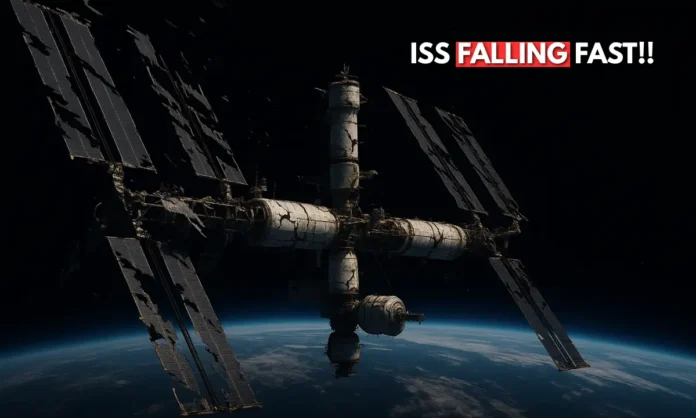SUMMARY
- NASA’s safety board has issued a rare “5 out of 5” risk alert for the ISS due to structural failures, missing parts, and budget cuts.
- The station lacks a working deorbit plan; if it collapses early, over 450 tons could crash back to Earth uncontrolled.
- Space suits, life support systems, and resupply ships are increasingly unreliable—some date back to the 1970s.
Space on the Edge: The International Space Station’s Most Dangerous Hour
The International Space Station has long stood as a symbol of peaceful global collaboration and human scientific ambition. But after more than 25 years in orbit, its mission is now under existential threat. The Aerospace Safety Advisory Panel (ASAP) of NASA recently sounded the alarm: the ISS is officially in its most unstable condition since its inception. Critical cracks, obsolete technology, evaporating budgets, and the absence of a tested retirement vehicle have turned the ISS from a floating laboratory into a high-risk liability.
The most disturbing revelation? The emergency “deorbit” spacecraft to bring it down safely hasn’t even been built yet. And if the ISS starts breaking apart before 2030, its uncontrolled descent could scatter debris across the planet.
🚨🇺🇸NASA: THE INTERNATIONAL SPACE STATION IS FALLING APART – AND THERE’S NO BACKUP PLAN
— Mario Nawfal (@MarioNawfal) April 25, 2025
The ISS — a giant science lab floating 250 miles above Earth — has been running nonstop since 1998, but now it’s falling apart fast.
Cracks in the Russian Zvezda module have been leaking air… pic.twitter.com/iJPQjkPUf0
Cracks, Leaks, and Obsolescence: Anatomy of a Failing Station
- The Zvezda module has suffered repeated structural cracks since 2019, including an alarming air leak in April 2024.
- ASAP has rated the ISS’s current status as “Risk 5 out of 5”—the highest level of danger.
- Aging suits, parts, and hardware designed in the 1970s–1990s are increasingly failing during missions.
The Russian-built Zvezda service module has become a pressure point—literally. Since 2019, cracks have emerged, culminating in a near-critical air leak in 2024 that required sealing off a key transfer tunnel.
NASA’s safety panel classified the issue as maximum risk. The 5-out-of-5 rating isn’t symbolic—it represents an imminent threat to crew safety, system integrity, and Earth-based fallout should the station destabilize.
Many of the ISS’s operational systems and suits were designed before the internet boom. Some suppliers no longer exist, and in 2024, a spacewalk had to be aborted due to a coolant leak—eerily reminiscent of the near-fatal water leak in astronaut Luca Parmitano’s helmet in 2013.
No Exit Plan, No Backup Ship, and Time Is Running Out
- SpaceX’s deorbit vehicle (USDV), meant to bring down the ISS safely by 2030–31, does not yet exist.
- Elon Musk suggests decommissioning by 2027—but without USDV, that could mean disaster.
- Support craft like Boeing’s Starliner and Russia’s Progress are also showing critical faults.
NASA’s current strategy hinges on a theoretical spacecraft—the USDV—that would nudge the ISS safely into the Pacific Ocean for a controlled reentry. The problem? That ship is still a concept.
If an emergency destabilizes the ISS before the vehicle is ready, the station could crash uncontrollably to Earth. At 450+ tons, this isn’t a satellite—it’s a floating city falling from the sky.
Compounding the crisis are systemic failures across support vehicles. Russia’s Progress MS-29 delivered contaminated air. Boeing’s Starliner failed key thruster tests. Some missions have been outright cancelled. The ISS has no dependable lifeline.
Shrinking Budgets and Growing Risks: Can the ISS Survive to 2030?
- The station’s operational budget dropped from $1.03 billion in 2023 to $993 million in 2024.
- Funds are now being rerouted toward future commercial stations and the deorbit vehicle.
- Experts warn that extending ISS operations without resources or safety upgrades is reckless.
Instead of receiving more support in its final years, the ISS is being asked to do more with less. Despite heightened risk and rising repair costs, NASA’s ISS budget has fallen—while money is diverted to build future orbital platforms that don’t yet exist.
Meanwhile, Elon Musk has floated the idea of shutting the station down by 2027. But without a retirement ship, that scenario would be anything but graceful.
Experts are increasingly convinced that the station cannot—and should not—continue in its current state. Every month brings new faults, more budget strain, and less time to act.
Orbital Endgame: Humanity Must Choose Responsibility Over Nostalgia
The ISS once represented the best of human cooperation. But like all aging systems, it’s approaching a natural end. What matters now is how that end is managed.
Keeping the station alive on outdated hardware, fractured modules, and unstable budgets is no longer a solution—it’s a gamble.
NASA and global partners must make urgent choices: either fund immediate overhauls, accelerate the USDV development, or admit that 2030 is too optimistic and begin a faster, safer exit.
Because if the ISS breaks down before a plan is in place, it won’t be remembered as a beacon of science—it’ll be remembered as a catastrophe we saw coming and failed to prevent.


